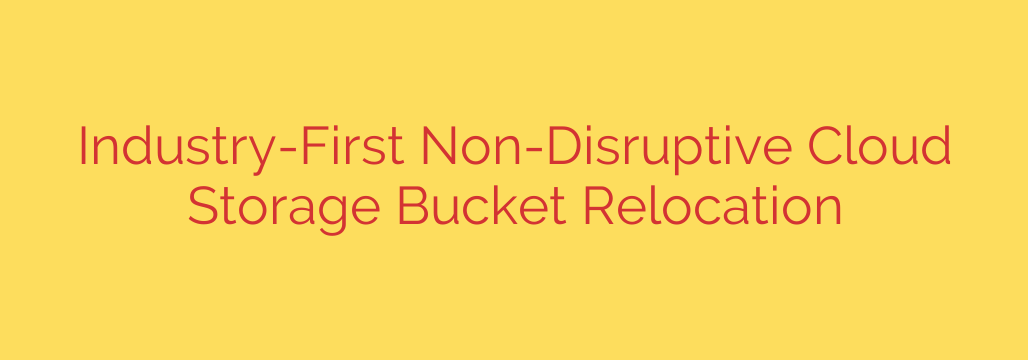
Seamless Cloud Storage Relocation: What You Need to Know About Non-Disruptive Data Movement
Moving large volumes of data in the cloud has historically presented a significant challenge. For organizations managing petabytes of information stored in cloud storage buckets, tasks like relocating data between regions for compliance, optimizing performance, or rebalancing costs often came with a steep price: downtime. Traditional methods typically require taking applications and services offline while data is copied, verified, and switched over. This disruption can impact business operations, customer access, and revenue.
However, a significant advancement in cloud infrastructure is changing this landscape. A new capability allows for the non-disruptive relocation of cloud storage buckets. This means data can be moved from one location or underlying storage service to another without requiring applications or users to stop accessing it.
The Pain Point: Why Traditional Migration Was Difficult
Before this innovation, migrating cloud storage buckets involved complex, multi-step processes. Planning alone could take weeks or months, involving careful coordination to minimize the impact of the required downtime. Even with meticulous execution, there were inherent risks associated with cutting over from the old location to the new one. For businesses that operate 24/7, any downtime is unacceptable and costly.
The Breakthrough: Non-Disruptive Relocation
The core concept behind this new capability is allowing live data access during the migration process. Imagine being able to move vast amounts of data – petabytes even – from one storage bucket location or service to another, all while your applications continue reading and writing data seamlessly.
This is achieved through sophisticated data management techniques that essentially create a live mirror of the data at the destination while maintaining access at the source. Once the initial copy is complete, subsequent changes are synchronized incrementally. Only when the destination is fully caught up and verified does the system seamlessly switch access to the new location.
Key Benefits for Your Business
The ability to move cloud storage buckets without disruption unlocks several critical advantages:
- Eliminate Downtime: The most significant benefit is the complete removal of planned downtime associated with data relocation, ensuring continuous business operations.
- Maintain Business Continuity: Applications and services connected to the storage bucket remain online and functional throughout the migration process.
- Reduce Operational Risk: Complex cutover procedures, a major source of errors and unplanned outages in traditional migrations, are minimized or eliminated.
- Enhance Agility and Flexibility: Organizations gain unprecedented flexibility to move data as business needs change – whether driven by compliance, performance, or cost optimization.
- Simplify Complex Migrations: Tasks like consolidating data from mergers, rebalancing data across regions, or changing storage tiers become significantly less complex and risky.
Practical Applications
This non-disruptive capability is particularly valuable for organizations facing scenarios such as:
- Meeting evolving data residency and compliance mandates that require data to be moved to specific geographic locations.
- Optimizing application performance by moving data closer to users or compute resources.
- Balancing workloads, costs, or utilization across different cloud regions or storage services.
- Facilitating mergers, acquisitions, or divestitures that require consolidation or separation of data assets.
What This Means for Your Cloud Strategy
The introduction of non-disruptive cloud storage bucket relocation marks a significant step forward in cloud data management. It transforms a challenging, risky, and disruptive process into a routine operation.
For businesses leveraging or considering cloud storage, this highlights the importance of:
- Evaluating Provider Capabilities: Look for cloud providers offering advanced data management features like non-disruptive migration.
- Planning for Flexibility: Design your cloud architecture with the understanding that data can be moved more easily in the future.
- Leveraging New Options: Explore how this capability can address existing challenges related to data residency, performance, or cost without forcing application downtime.
Ultimately, this innovation provides organizations with greater control, flexibility, and reliability in managing their critical data assets in the cloud. It simplifies complex tasks and reduces the business risk traditionally associated with large-scale data movement.
Source: https://cloud.google.com/blog/products/storage-data-transfer/introducing-cloud-storage-bucket-relocation/








